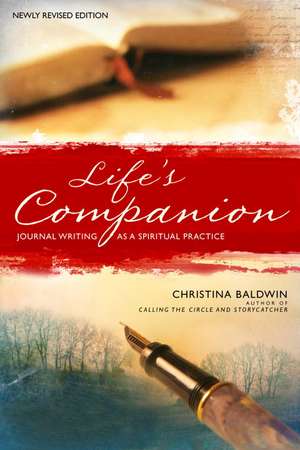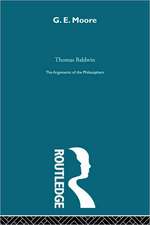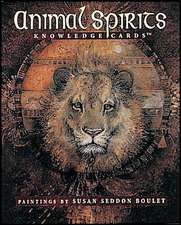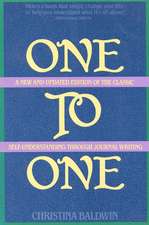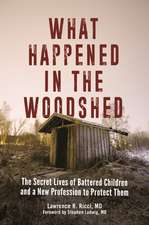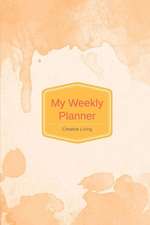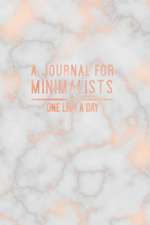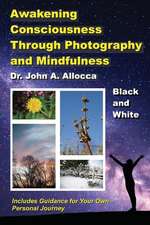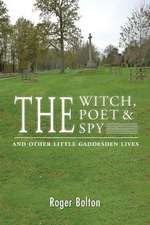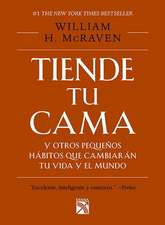Life's Companion: Journal Writing as a Spiritual Practice
Autor Christina Baldwin, Roger Bolton Ilustrat de Susan Seddon Bouleten Limba Engleză Paperback – 30 noi 1990
Complete with enlightening quotations, exercises, sample journal entries, and techniques to nurture and encourage the writer and seeker within you, Life’s Companion will help you transform journaling into a powerful tool for self-growth, heightened awareness, and personal fulfillment.
Preț: 123.87 lei
Nou
Puncte Express: 186
Preț estimativ în valută:
23.71€ • 24.66$ • 19.57£
23.71€ • 24.66$ • 19.57£
Carte disponibilă
Livrare economică 25 martie-08 aprilie
Preluare comenzi: 021 569.72.76
Specificații
ISBN-13: 9780553352023
ISBN-10: 0553352024
Pagini: 366
Dimensiuni: 152 x 229 x 23 mm
Greutate: 0.5 kg
Ediția:Newly REV
Editura: Bantam
ISBN-10: 0553352024
Pagini: 366
Dimensiuni: 152 x 229 x 23 mm
Greutate: 0.5 kg
Ediția:Newly REV
Editura: Bantam
Notă biografică
Christina Baldwin is the author of Calling the Circle, Seven Whispers, and most recently Storycatcher, which won a 2006 Books for a Better Life Award. She teaches and lectures extensively through her educational company, PeerSpirit. She lives outside Seattle, Washington, on Whidbey Island.
Extras
Chapter One
Journeys and Journals
I have always known that at last I would take this road, but yesterday I did not know that it would be today.—Narihara
There comes a journey . . . And there also comes the urge to write it down, to bear witness to our experience, to share our questions and the insights that come from questioning.
The spiritual journey is the one trip we are all taking together. You may be in a bookstore, a grocery store, at a restaurant, or home in bed. Whatever you think you're doing, whatever else you identify as happening, you are also somewhere in the middle of your spiritual journey. The spiritual journey is the part of life that is the path within the path. Spirituality is the sacred center out of which all life comes, including Mondays and Tuesdays and rainy Saturday afternoons in all their mundane and glorious detail.
The spiritual journey is what the soul is up to while we attend to daily living. The spiritual journey is the soul's life commingling with ordinary life. The fabric tears: the soul sees Monday, Monday sees the soul.
The purpose of this book is to facilitate the commingling between spiritual and ordinary life, to allow us to see both aspects more clearly and to live both aspects more fully. And the easiest, most efficient, and most delightful way I know to watch these levels of life commingle is to write down the details and stories of our lives as we go. This is journal writing as a spiritual practice.
Choosing a Journal
Journal writing is a practice that requires tools and leaves evidence. If you are writing by hand, you will go through a process of finding just the right paper, the size and shape and weight of book that you want to carry along with you. You will choose favorite pens. Formats will evolve over time. If you are typing, you are most likely working on an electronic keyboard, with your words appearing before you on a computer screen. You may be using journaling software or a word-processing program. You may store files inside your computer, or venture online and into the world of blogging and other interactive programs in which the journal creates a dialogue between unseen companions.
If you are new to journal writing or looking to renew your relationship to a habit that has grown stale, I invite you to experiment, to notice what best helps you have the conversation with yourself that you want.
For some people, handwriting feels slow and awkward; for others, the shift in pace is exactly what they need to reach the interior story and bring it forth to the page. Some people like to type. Some people like to write. There is not a right or wrong way to write; there is only your way. The act of writing needs to be comfortable and enjoyable, to become part of the spiritual practice so you can focus on content, on what you are saying to yourself.
Once you have decided on your tools, you'll need to think about what to do with the journal itself. Whether you have a collection of old notebooks or electronic files on a laptop, storage is part of the journal-writing process. You may not be ready to answer the question "What do I want done with my journal when I die?" but you need to be ready to answer the question "What do I do with my journal when I'm done writing for the day?" For some writers, privacy is extremely important; for other writers, response and dialogue are extremely important. You may need to have a conversation with a partner and other family members about your privacy needs and whether or not it's okay for them to pick up your journal or open your files. Depending on your privacy requirements, you need to put your journal, tangibly or electronically, where it is protected and cannot be read by others unless you invite that sharing. The litmus test for privacy is: do you feel free to write what you want without inhibiting yourself?
I notice my privacy needs have changed over time. I started off in my teen years with a padlock on my notebook and an elaborate hiding system while hardly saying anything that I'd now consider risque. After decades of writing I've gained a greater acceptance of myself and my story and I worry less about other people's judgments. Most of the time my journal is lying around visibly in the vicinity of my desk.
In my own family, my partner and I each keep journals and respect the other's privacy. Every few months we will sit down and read selected entries aloud to one another. We often end up having lovely conversations based on what we've shared. When company arrives, we tuck the journals into a drawer. We've named each other as literary executors and have a backup plan if we die at the same time, but we really don't know what's going to happen to all this evidence of the writing journey. Is it important? Should we have a huge bonfire? Should we send the boxes off somewhere for storage—in the archives of a state historical society, held by an alma mater, scanned into some electronic memory bank? We don't know. Meanwhile, we just keep writing with the belief that we'll take care of the journals as best we can when the time comes to make a decision. Right now, it's the practice, the ongoing learning, that is our focus.
I type for a living, and have always kept my journal by hand. Typing turns on a part of my brain that assesses the quality of my communication skills and shifts focus to the intended reader. Writing opens a part of my mind that experiences meditation and focuses on my own thoughts, feelings, and insights. Writing is intimate, and the smell of fountain pen ink and the feel of smooth paper under the edge of my palm invoke a state of being where I am both reader and writer, questioner and responder.
Because of my own history, and because journal writing is a contemplative act, I will speak throughout this book of pages and pens—and you do what works for you.
Writing makes a map, and there is something about a journey that begs to have its passage marked.
Marking passage is an ordinary process. The journey is already ongoing; it's simply a matter of acknowledging it. And the journal is an adaptable practice that can absorb as much or as little attention as you apply to it. It will fluctuate cheerfully, without complaints. The journal takes you and your journey as you are.
I first used the phrase "There comes a journey . . ." when picking up my journal again after a year of not writing. I wanted to declare a purpose, to write down the contract I was making with the universe. I had already been journeying, of course, we all are, but I wanted to state clearly my intention to accept this journey with awareness, to learn to take responsibility.
Who Writes?
Imagine walking down a path, participating in everything around you. You notice actions near and far; you interact with people and deal with challenges and opportunities along the way. This is the walker: the active self. The active self is understood and acknowledged in the world of action. Words and phrases such as "responsible," "team player," "decisive," "concrete," and "action-oriented" all describe the active self.
Imagine a mirror path running parallel to the path you're walking. The mirror path reflects feelings, thoughts, attitudes, and beliefs about what is happening. This is the watcher, the reflective self. The reflective self is understood and acknowledged in the world of thought. Words and phrases such as "thought-provoking," "inspirational," "questioning," "observant," "probing," and "philosophical" all describe the reflective self.
Together these two selves create consciousness, the awareness of ourselves interacting within our own existence. Consciousness is our second birth, the birth of our capacity to reflect upon and wonder about experience. Consciousness connects action and thought. Consciousness is our primary companionship, the company we keep inside ourselves. Consciousness is not just the angel/devil voices of cartoon characters sitting on our shoulders, but a multitude of opinions, reflections, and points of guidance all mixed in with archaic, rote memorizations of how to be a human being—not all of them helpful.
When we take up the spiritual journey, we activate the walker and the watcher and become aware of consciousness as an ongoing, intimate dialogue within the self. Conscious people are aware of the influence and guidance available through inner dialogue. The map of the journey most often comes from within. The question arises: how does one keep track of what consciousness offers and sort through the mind to the spiritual layer?
So now imagine a spiritual practice that allows you to contemplate the paths of action and reflection. From this practice you can observe both the walker and the watcher. You record action and reflection upon action. You hear the mind's commentary. This is the writer: the self who acts and reflects on paper. The writer self is understood and acknowledged in the world of story. Word and phrases such as "that makes sense," "now I see," "context," "legacy," "life lesson," "insight," and "integration" all describe the writer.
The twenty-four chapters presented here are designed to make a map of the spiritual journey. Your journey and mine may look quite different, yet we travel through common life elements. Through writing we connect our journeys to the experience of a multitude of life travelers before, after, and all around us. We can learn tremendously from others and their writings, and still—we have to make our own way.
We call spirituality a journey and speak in metaphors of travel, yet many of us never leave the neighborhood. The journal becomes the metaphor made real, a travelogue of the mind. There are other ways to travel the spiritual journey, but the tangibility of writing and its ability to make story out of life experience become important qualities on a journey that is largely metaphoric.
On days when I'm not sure what the journey is or why I'm on it, I can still be sure what the journal is and why I write. I can hold on to my journal, write in it, lament and question and celebrate. My journal goes with me nearly everywhere. When I'm home, journal and pen wait receptively on my desk. When I'm driving around town, it's on the car seat beside me, waiting for a few minutes when I can catch up with my thoughts. When I travel by air, it's tucked next to me under the seat belt. When I'm in bed, it's on the nightstand.
My journal is my life's companion. The format evolves, the pens change, the contents vary, the cast of characters comes and goes. Yet this tangible object reminds me that my life is being lived on many levels; it reminds me that I need to act, reflect, write, and then act more clearly. It urges me to remember to pay attention to spirit, to be led rather than lead.
I deliberately imbue whatever notebook is the journal of the moment with all these properties. I ask it to serve as a talisman of the quest, visible every day, even on days when I don't write.
Since the early 1970s, when I wandered into an adult education center, admitted I kept a journal, and asked if anybody ever taught a course about it, I have been teaching and learning from tens of thousands of journal writers.
We are living in a renaissance of personal writing. People are rebalancing the impersonalization of modern society with an increase in personal introspection and the reclamation of story. We are undergoing a shift in paradigms in which we are challenged to develop new models for humanness and human responsibility. Every time we look around, our individual lives are confronted with the need to respond adequately to both inner and outer change. And we feel a sense of urgency: will we face our challenges in time to preserve the world that sustains us?
In the polarity of the times, we are asked—and are asking ourselves—to lead lives that succeed in both a worldly sense and a spiritual one. We are asking ourselves to integrate forces long regarded as diametrically opposed. We are trying to refashion the spiritual path to bring it into the world of rainy afternoons, and also refashion our lives to take spirituality more deeply into account in our daily affairs.
We go to work, come home tired, make supper, do laundry, watch over the children, talk to our spouses or partners or friends. There's nothing good on TV. We try to glimpse life's meaning in trips to the grocery store, conversations about the weather, newspaper headlines, thoughts about how things are at work or at home and how our lives are turning out. We feel vulnerable and perhaps disappointed. Something has shifted under us that we thought we could count on, an assumption about reality we never named, and now it isn't there. We're trying to figure something out and we don't know how to help ourselves. We are waiting for the way to be made clear, only there doesn't seem to be "a way." This is a perplexing situation, but confusion is the way pilgrimages and journals most often begin.
Despite the pressure of the times, the spiritual journey cannot be forced to grow like a hothouse bulb. The best any of us can do is ready ourselves with spiritual openness that we have practiced during the lulls in life, so that when the turning points come, we have a structure in place to help us decide which way to turn. We practice finding spirituality in the ordinary so that we may recognize it in the extraordinary.
What I think we are up to, we throngs of journal-writing pilgrims, is reclamation. We are searching for ways to reclaim a sense of place, a sense of empowerment, a sense of healthy relationship between our lives and our times. We look for whatever can help us make sense of the moment.
We write.
Chapter Two
How to Write a Spiritual Journal
I want to write, but more than that, I want to bring out all kinds of things that lie buried in my heart.—Anne Frank, The Diary of a Young Girl
For Christmas, the year I was twelve, my mother gave me a pair of tickets to the touring-company production of The Diary of Anne Frank. Appropriate to both the Frank family dynamics and my own, it was my father who escorted me to the play. Sitting in the dark, I quickly identified with this earnest, articulate girl, confined with her family in hiding from the Nazis while her mind and spirit soared on paper.
Like thousands of other young girls, I saw in Anne a sister-self. It was the first time anything about art, life, writing, or individuality struck me with full force. By the time the dreadful knocks finally came on the annex door and the curtain fell, I was awash in grief.
I had loved Anne and lost her in two short hours. She was a mirror for the self I wanted to be; and so this was also the first time I had ever projected love toward myself or guessed at my own lost wandering.
Journeys and Journals
I have always known that at last I would take this road, but yesterday I did not know that it would be today.—Narihara
There comes a journey . . . And there also comes the urge to write it down, to bear witness to our experience, to share our questions and the insights that come from questioning.
The spiritual journey is the one trip we are all taking together. You may be in a bookstore, a grocery store, at a restaurant, or home in bed. Whatever you think you're doing, whatever else you identify as happening, you are also somewhere in the middle of your spiritual journey. The spiritual journey is the part of life that is the path within the path. Spirituality is the sacred center out of which all life comes, including Mondays and Tuesdays and rainy Saturday afternoons in all their mundane and glorious detail.
The spiritual journey is what the soul is up to while we attend to daily living. The spiritual journey is the soul's life commingling with ordinary life. The fabric tears: the soul sees Monday, Monday sees the soul.
The purpose of this book is to facilitate the commingling between spiritual and ordinary life, to allow us to see both aspects more clearly and to live both aspects more fully. And the easiest, most efficient, and most delightful way I know to watch these levels of life commingle is to write down the details and stories of our lives as we go. This is journal writing as a spiritual practice.
Choosing a Journal
Journal writing is a practice that requires tools and leaves evidence. If you are writing by hand, you will go through a process of finding just the right paper, the size and shape and weight of book that you want to carry along with you. You will choose favorite pens. Formats will evolve over time. If you are typing, you are most likely working on an electronic keyboard, with your words appearing before you on a computer screen. You may be using journaling software or a word-processing program. You may store files inside your computer, or venture online and into the world of blogging and other interactive programs in which the journal creates a dialogue between unseen companions.
If you are new to journal writing or looking to renew your relationship to a habit that has grown stale, I invite you to experiment, to notice what best helps you have the conversation with yourself that you want.
For some people, handwriting feels slow and awkward; for others, the shift in pace is exactly what they need to reach the interior story and bring it forth to the page. Some people like to type. Some people like to write. There is not a right or wrong way to write; there is only your way. The act of writing needs to be comfortable and enjoyable, to become part of the spiritual practice so you can focus on content, on what you are saying to yourself.
Once you have decided on your tools, you'll need to think about what to do with the journal itself. Whether you have a collection of old notebooks or electronic files on a laptop, storage is part of the journal-writing process. You may not be ready to answer the question "What do I want done with my journal when I die?" but you need to be ready to answer the question "What do I do with my journal when I'm done writing for the day?" For some writers, privacy is extremely important; for other writers, response and dialogue are extremely important. You may need to have a conversation with a partner and other family members about your privacy needs and whether or not it's okay for them to pick up your journal or open your files. Depending on your privacy requirements, you need to put your journal, tangibly or electronically, where it is protected and cannot be read by others unless you invite that sharing. The litmus test for privacy is: do you feel free to write what you want without inhibiting yourself?
I notice my privacy needs have changed over time. I started off in my teen years with a padlock on my notebook and an elaborate hiding system while hardly saying anything that I'd now consider risque. After decades of writing I've gained a greater acceptance of myself and my story and I worry less about other people's judgments. Most of the time my journal is lying around visibly in the vicinity of my desk.
In my own family, my partner and I each keep journals and respect the other's privacy. Every few months we will sit down and read selected entries aloud to one another. We often end up having lovely conversations based on what we've shared. When company arrives, we tuck the journals into a drawer. We've named each other as literary executors and have a backup plan if we die at the same time, but we really don't know what's going to happen to all this evidence of the writing journey. Is it important? Should we have a huge bonfire? Should we send the boxes off somewhere for storage—in the archives of a state historical society, held by an alma mater, scanned into some electronic memory bank? We don't know. Meanwhile, we just keep writing with the belief that we'll take care of the journals as best we can when the time comes to make a decision. Right now, it's the practice, the ongoing learning, that is our focus.
I type for a living, and have always kept my journal by hand. Typing turns on a part of my brain that assesses the quality of my communication skills and shifts focus to the intended reader. Writing opens a part of my mind that experiences meditation and focuses on my own thoughts, feelings, and insights. Writing is intimate, and the smell of fountain pen ink and the feel of smooth paper under the edge of my palm invoke a state of being where I am both reader and writer, questioner and responder.
Because of my own history, and because journal writing is a contemplative act, I will speak throughout this book of pages and pens—and you do what works for you.
Writing makes a map, and there is something about a journey that begs to have its passage marked.
Marking passage is an ordinary process. The journey is already ongoing; it's simply a matter of acknowledging it. And the journal is an adaptable practice that can absorb as much or as little attention as you apply to it. It will fluctuate cheerfully, without complaints. The journal takes you and your journey as you are.
I first used the phrase "There comes a journey . . ." when picking up my journal again after a year of not writing. I wanted to declare a purpose, to write down the contract I was making with the universe. I had already been journeying, of course, we all are, but I wanted to state clearly my intention to accept this journey with awareness, to learn to take responsibility.
Who Writes?
Imagine walking down a path, participating in everything around you. You notice actions near and far; you interact with people and deal with challenges and opportunities along the way. This is the walker: the active self. The active self is understood and acknowledged in the world of action. Words and phrases such as "responsible," "team player," "decisive," "concrete," and "action-oriented" all describe the active self.
Imagine a mirror path running parallel to the path you're walking. The mirror path reflects feelings, thoughts, attitudes, and beliefs about what is happening. This is the watcher, the reflective self. The reflective self is understood and acknowledged in the world of thought. Words and phrases such as "thought-provoking," "inspirational," "questioning," "observant," "probing," and "philosophical" all describe the reflective self.
Together these two selves create consciousness, the awareness of ourselves interacting within our own existence. Consciousness is our second birth, the birth of our capacity to reflect upon and wonder about experience. Consciousness connects action and thought. Consciousness is our primary companionship, the company we keep inside ourselves. Consciousness is not just the angel/devil voices of cartoon characters sitting on our shoulders, but a multitude of opinions, reflections, and points of guidance all mixed in with archaic, rote memorizations of how to be a human being—not all of them helpful.
When we take up the spiritual journey, we activate the walker and the watcher and become aware of consciousness as an ongoing, intimate dialogue within the self. Conscious people are aware of the influence and guidance available through inner dialogue. The map of the journey most often comes from within. The question arises: how does one keep track of what consciousness offers and sort through the mind to the spiritual layer?
So now imagine a spiritual practice that allows you to contemplate the paths of action and reflection. From this practice you can observe both the walker and the watcher. You record action and reflection upon action. You hear the mind's commentary. This is the writer: the self who acts and reflects on paper. The writer self is understood and acknowledged in the world of story. Word and phrases such as "that makes sense," "now I see," "context," "legacy," "life lesson," "insight," and "integration" all describe the writer.
The twenty-four chapters presented here are designed to make a map of the spiritual journey. Your journey and mine may look quite different, yet we travel through common life elements. Through writing we connect our journeys to the experience of a multitude of life travelers before, after, and all around us. We can learn tremendously from others and their writings, and still—we have to make our own way.
We call spirituality a journey and speak in metaphors of travel, yet many of us never leave the neighborhood. The journal becomes the metaphor made real, a travelogue of the mind. There are other ways to travel the spiritual journey, but the tangibility of writing and its ability to make story out of life experience become important qualities on a journey that is largely metaphoric.
On days when I'm not sure what the journey is or why I'm on it, I can still be sure what the journal is and why I write. I can hold on to my journal, write in it, lament and question and celebrate. My journal goes with me nearly everywhere. When I'm home, journal and pen wait receptively on my desk. When I'm driving around town, it's on the car seat beside me, waiting for a few minutes when I can catch up with my thoughts. When I travel by air, it's tucked next to me under the seat belt. When I'm in bed, it's on the nightstand.
My journal is my life's companion. The format evolves, the pens change, the contents vary, the cast of characters comes and goes. Yet this tangible object reminds me that my life is being lived on many levels; it reminds me that I need to act, reflect, write, and then act more clearly. It urges me to remember to pay attention to spirit, to be led rather than lead.
I deliberately imbue whatever notebook is the journal of the moment with all these properties. I ask it to serve as a talisman of the quest, visible every day, even on days when I don't write.
Since the early 1970s, when I wandered into an adult education center, admitted I kept a journal, and asked if anybody ever taught a course about it, I have been teaching and learning from tens of thousands of journal writers.
We are living in a renaissance of personal writing. People are rebalancing the impersonalization of modern society with an increase in personal introspection and the reclamation of story. We are undergoing a shift in paradigms in which we are challenged to develop new models for humanness and human responsibility. Every time we look around, our individual lives are confronted with the need to respond adequately to both inner and outer change. And we feel a sense of urgency: will we face our challenges in time to preserve the world that sustains us?
In the polarity of the times, we are asked—and are asking ourselves—to lead lives that succeed in both a worldly sense and a spiritual one. We are asking ourselves to integrate forces long regarded as diametrically opposed. We are trying to refashion the spiritual path to bring it into the world of rainy afternoons, and also refashion our lives to take spirituality more deeply into account in our daily affairs.
We go to work, come home tired, make supper, do laundry, watch over the children, talk to our spouses or partners or friends. There's nothing good on TV. We try to glimpse life's meaning in trips to the grocery store, conversations about the weather, newspaper headlines, thoughts about how things are at work or at home and how our lives are turning out. We feel vulnerable and perhaps disappointed. Something has shifted under us that we thought we could count on, an assumption about reality we never named, and now it isn't there. We're trying to figure something out and we don't know how to help ourselves. We are waiting for the way to be made clear, only there doesn't seem to be "a way." This is a perplexing situation, but confusion is the way pilgrimages and journals most often begin.
Despite the pressure of the times, the spiritual journey cannot be forced to grow like a hothouse bulb. The best any of us can do is ready ourselves with spiritual openness that we have practiced during the lulls in life, so that when the turning points come, we have a structure in place to help us decide which way to turn. We practice finding spirituality in the ordinary so that we may recognize it in the extraordinary.
What I think we are up to, we throngs of journal-writing pilgrims, is reclamation. We are searching for ways to reclaim a sense of place, a sense of empowerment, a sense of healthy relationship between our lives and our times. We look for whatever can help us make sense of the moment.
We write.
Chapter Two
How to Write a Spiritual Journal
I want to write, but more than that, I want to bring out all kinds of things that lie buried in my heart.—Anne Frank, The Diary of a Young Girl
For Christmas, the year I was twelve, my mother gave me a pair of tickets to the touring-company production of The Diary of Anne Frank. Appropriate to both the Frank family dynamics and my own, it was my father who escorted me to the play. Sitting in the dark, I quickly identified with this earnest, articulate girl, confined with her family in hiding from the Nazis while her mind and spirit soared on paper.
Like thousands of other young girls, I saw in Anne a sister-self. It was the first time anything about art, life, writing, or individuality struck me with full force. By the time the dreadful knocks finally came on the annex door and the curtain fell, I was awash in grief.
I had loved Anne and lost her in two short hours. She was a mirror for the self I wanted to be; and so this was also the first time I had ever projected love toward myself or guessed at my own lost wandering.
Descriere
In a unique facing-page format, this book on journal writing and iner development combines guidance through the stages of the spiritual journey with illuminating quotations, dozens of ideas for writing practice, and sample entries taken from the author's journal workshops.
